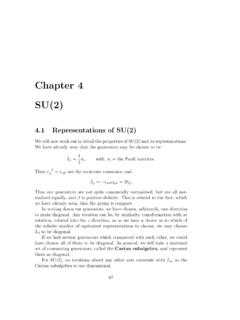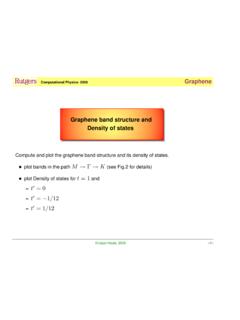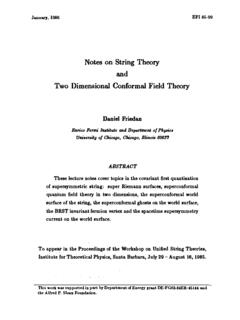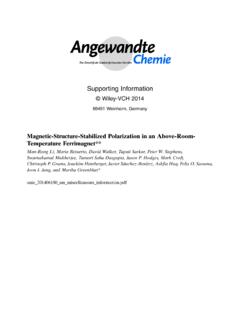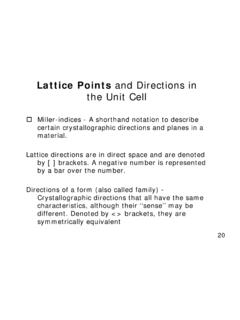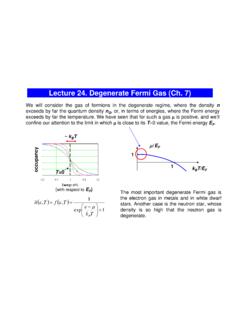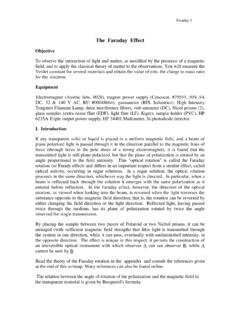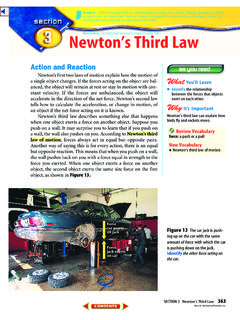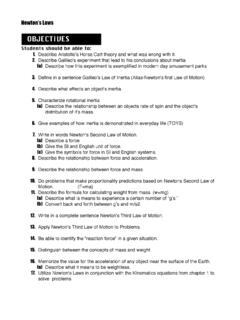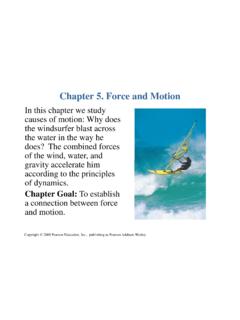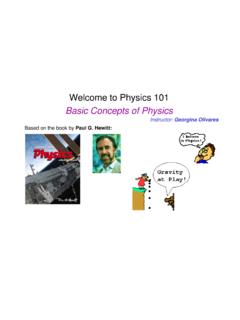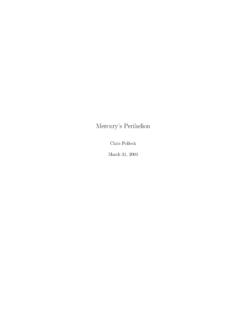Transcription of Chapter 2 Lagrange’s and Hamilton’s Equations
1 Chapter 2 lagrange 's and hamilton 'sEquationsIn this Chapter , we consider two reformulations of Newtonian mechanics, theLagrangian and the Hamiltonian formalism. The rst is naturally associatedwith con guration space, extended by time, while the latter is the naturaldescription for working in phase developed his approach in 1764 in a study of the libration ofthe moon, but it is best thought of as a general method of treating dynamicsin terms of generalized coordinates for con guration space. It so transcendsits origin that the Lagrangian is considered the fundamental object whichdescribes a quantum eld 's approach arose in 1835 in his uni cation of the language ofoptics and mechanics.
2 It too had a usefulness far beyond its origin, andthe Hamiltonian is now most familiar as the operator in quantum mechanicswhich determines the evolution in time of the wave begin by deriving lagrange 's equation as a simple change of coordi-nates in an unconstrained system, one which is evolving according to New-ton's laws with force laws given by some potential. Lagrangian mechanicsis also and especially useful in the presence of constraints, so we will thenextend the formalism to this more general 2. lagrange S AND hamilton S Lagrangian for unconstrained systemsFor a collection of particles with conservative forces described by a potential,we have in inertial cartesian coordinatesm xi=Fi:The left hand side of this equation is determined by the kinetic energy func-tion as the time derivative of the momentumpi=@T=@_xi, while the righthand side is a derivative of the potential energy, @ indepen-dent ofxiandUis independent of _xiin these coordinates, we can write bothsides in terms of theLagrangianL=T U, which is then a function ofboth the coordinates and their velocities.
3 Thus we have establishedddt@L@_xi @L@xi=0;which, once we generalize it to arbitrary coordinates, will be known as La-grange's equation. Note that we are treatingLas a function of the 2 Nindependent variablesxiand _xi, so that@L=@_ximeans vary one _xiholdingall the other _xjandallthexk xed. Making this particular combinationofT(_~r) withU(~r) to get the more complicatedL(~r;_~r) seems an arti cialconstruction for the inertial cartesian coordinates, but it has the advantageof preserving the form of lagrange 's Equations for any set of we did in section , we assume we have a set of generalized coor-dinatesfqjgwhich parameterize all of coordinate space, so that each pointmay be described by thefqjgor by thefxig,i;j2[1;N], and thus each setmay be thought of as a function of the other, and time:qj=qj(x1;:::xN;t)xi=xi(q1;:::qN;t): ( )We may considerLas a function1of the generalized coordinatesqjand _qj,1Of course we are not saying thatL(x;_x.)
4 T) is the same function of its coordinates asL(q;_q;t), but rather that these are two functions which agree at the corresponding physicalpoints. More precisely, we are de ning a new function~L(q;_q;t)=L(x(q;t);_x(q;_q;t);t ),but we are being physicists and neglecting the tilde. We are treating the Lagrangian hereas ascalarunder coordinate transformations, in the sense used in general relativity, thatits value at a given physical point is unchanged by changing the coordinate system usedto de ne that LAGRANGIAN FOR UNCONSTRAINED SYSTEMS37and ask whether the same expression in these coordinatesddt@L@_qj @L@qjalso vanishes. The chain rule tells us@L@_xj= k@L@qk@qk@_xj+ k@L@_qk@ rst term vanishes becauseqkdepends only on the coordinatesxkandt, but not on the _xk.
5 From the inverse relation to ( ),_qj= i@qj@xi_xi+@ have@_qj@_xi=@qj@xi:Using this in ( ),@L@_xi= j@L@_qj@ equation involves the time derivative of this. Here what ismeant is not a partial derivative@=@t, holding the point in con gurationspace xed, but rather the derivative along the path which the system takes asit moves through con guration space. It is called thestream derivative,aname which comes from fluid mechanics, where it gives the rate at which someproperty de ned throughout the fluid,f(~r;t), changes for a xed element offluid as the fluid as a whole flows. We write it as atotalderivative to indicatethat we are following the motion rather than evaluating the rate of changeat a xed point in space, as the partial derivative any functionf(x;t) of extended con guration space, this total timederivative isdfdt= j@f@xj_xj+@ Leibnitz' rule on ( ) and using ( ) in the second term, we ndddt@L@_xi= j(ddt@L@_qj)@qj@xi+ j@L@_qj( k@2qj@xi@xk_xk+@2qj@ 2.)
6 lagrange S AND hamilton S EQUATIONSOn the other hand, the chain rule also tells us@L@xi= j@L@qj@qj@xi+ j@L@_qj@_qj@xi;where the last term does not necessarily vanish, as _qjin general depends onboth the coordinates and velocities. In fact, from ,@_qj@xi= k@2qj@xi@xk_xk+@2qj@xi@t;so@L@xi= j@L@qj@qj@xi+ j@L@_qj( k@2qj@xi@xk_xk+@2qj@ equation in cartesian coordinates says ( ) and ( ) are equal,and in subtracting them the second terms cancel2,so0= j(ddt@L@_qj @L@qj)@qj@xi:The matrix@qj=@xiis nonsingular, as it has@xi=@qjas its inverse, so wehave derived lagrange 's Equation in generalized coordinates:ddt@L@_qj @L@qj=0:Thus we see that lagrange 's Equations are form invariant under changes ofthe generalized coordinates used to describe the con guration of the is primarily for this reason that this particular and peculiar combinationof kinetic and potential energy is useful.)
7 Note that we implicity assume theLagrangian itself transformed like a scalar, in that its value at a given phys-ical point of con guration space is independent of the choice of generalizedcoordinates that describe the point. The change of coordinates itself ( ) iscalled apoint is why we chose the particular combination we did for the Lagrangian, ratherthanL=T Ufor some 6= 1. Had we done so, lagrange 's equation in cartesiancoordinates would have been d(@L=@_xj)=dt @L=@xj= 0, and in the subtraction of( ) from ( ), the terms proportional to@L=@_qi(without a time derivative) wouldnot have LAGRANGIAN FOR CONSTRAINED Lagrangian for Constrained SystemsWe now wish to generalize our discussion to include contraints.
8 At the sametime we will also consider possibly nonconservative forces. As we mentionedin section , we often have a system with internal forces whose e ect isbetter understood than the forces themselves, with which we may not beconcerned. We will assume the constraints are holonomic, expressible askreal functions (~r1;:::;~rn;t) = 0, which are somehow enforced by constraintforces~FCion the particlesfig. There may also be other forces, which wewill callFDiand will treat as having a dynamical e ect. These are given byknown functions of the con guration and time, possibly but not necessarilyin terms of a distinction will seem arti cial without examples, so it would be wellto keep these two in mind.
9 In each of these cases the full con gurationspace isR3, but the constraints restrict the motion to an allowed subspaceof extended con guration In section we discussed a mass on a light rigid rod, the other endof which is xed at the origin. Thus the mass is constrained to havej~rj=L, and the allowed subspace of con guration space is the surfaceof a sphere, independent of time. The rod exerts the constraint forceto avoid compression or expansion. The natural assumption to make isthat the force is in the radial direction, and therefore has no componentin the direction of allowed motions, the tangential directions. That is,for all allowed displacements, ~r,wehave~FC ~r= 0, and the constraintforce does no Consider a bead free to slide without friction on the spoke of a rotatingbicycle wheel3, rotating about a xed axis at xed angular velocity!
10 That is, for the polar angle of inertial coordinates, := !t=0isa constraint4, but thercoordinate is unconstrained. Here the allowedsubspace is not time independent, but is a helical sort of structure inextended con guration space. We expect the force exerted by the spokeon the bead to be in the ^e direction. This is again perpendicular toanyvirtual displacement, by which we mean an allowed change in3 Unlike a real bicycle wheel, we are assuming here that the spoke is directly along aradius of the circle, pointing directly to the is also a constraintz= 2. lagrange S AND hamilton S EQUATIONScon gurationat a fixed time. It is important to distinguish this virtualdisplacement from a small segment of the trajectory of the particle.
